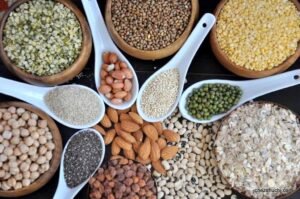Introduction: Whether you’re a committed vegetarian, exploring a plant-based lifestyle, or simply looking to diversify your protein sources, there’s a wealth of meatless options that can fuel your body with essential nutrients. In this blog post, we’ll explore a variety of plant-based foods that are not only rich in protein but also delicious and versatile.
Section 1: Legumes and Pulses

1.1 Chickpeas:
- Highlight chickpeas as a versatile protein source, suitable for salads, stews, and snacks.
- Share recipes for homemade hummus and roasted chickpea snacks.
1.2 Lentils:
- Discuss the protein and fiber content of lentils, making them a staple in vegetarian diets.
- Provide recipes for lentil soups, stews, and lentil-based burgers.
Section 2: Nuts and Seeds
2.1 Almonds:
- Emphasize the protein, healthy fats, and vitamin E found in almonds.
- Suggest almond butter as a tasty spread or dip.
2.2 Chia Seeds:
- Explore the protein, omega-3 fatty acids, and fiber in chia seeds.
- Include chia pudding recipes for a nutritious breakfast or snack.
Section 3: Whole Grains
3.1 Quinoa:
- Discuss quinoa as a complete protein, containing all essential amino acids.
- Share recipes for quinoa salads, bowls, and as a substitute for rice.
3.2 Oats:
- Highlight the protein and fiber content of oats.
- Offer creative recipes for protein-packed oatmeal and energy bars.
Section 4: Tofu and Tempeh
4.1 Tofu:
- Discuss tofu’s versatility and protein content.
- Share recipes for marinated and grilled tofu, stir-fries, and smoothies.
4.2 Tempeh:
- Introduce tempeh as a fermented soy product rich in protein and probiotics.
- Provide recipes for tempeh stir-fries, sandwiches, and salads.
Section 5: Plant-Based Dairy Alternatives
5.1 Greek Yogurt Alternatives:
- Explore dairy-free yogurt options made from coconut, almond, or soy.
- Share ideas for incorporating plant-based yogurts into smoothies and desserts.
5.2 Nutritional Yeast:
- Highlight nutritional yeast as a protein-rich, cheesy-flavored seasoning.
- Suggest using it in sauces, dressings, and as a popcorn topping.
Conclusion: Transitioning to a more plant-based diet doesn’t mean sacrificing protein intake. By incorporating legumes, nuts, seeds, whole grains, tofu, tempeh, and plant-based dairy alternatives into your meals, you can enjoy a diverse and satisfying range of meatless protein sources. Experiment with different recipes and discover new favorites that align with your dietary preferences and health goals.




